Introduction
In today’s complex environment, setting and executing on a strategy to optimize value across all stakeholders has never been more challenging. Markets, technology, and consumers are changing faster than organizations can adapt.
Evidence shows that digital leaders outperform their peers in top-line revenue growth and overall value creation. A study from Harvard Business Review revealed a nearly 20-point difference in revenue growth between digital leaders and digital laggards.
Modern CEOs aren’t just running companies – they’re managing complicated ecosystems, which makes designing and implementing digital strategy all the more challenging.
The challenge of ‘digital’ strategy
In a recent study, 87% of respondents believe their industry and business will be disrupted by digital. Only 44% felt adequately prepared for these disruptions. And even those that are working on solutions may be starting in the wrong place.
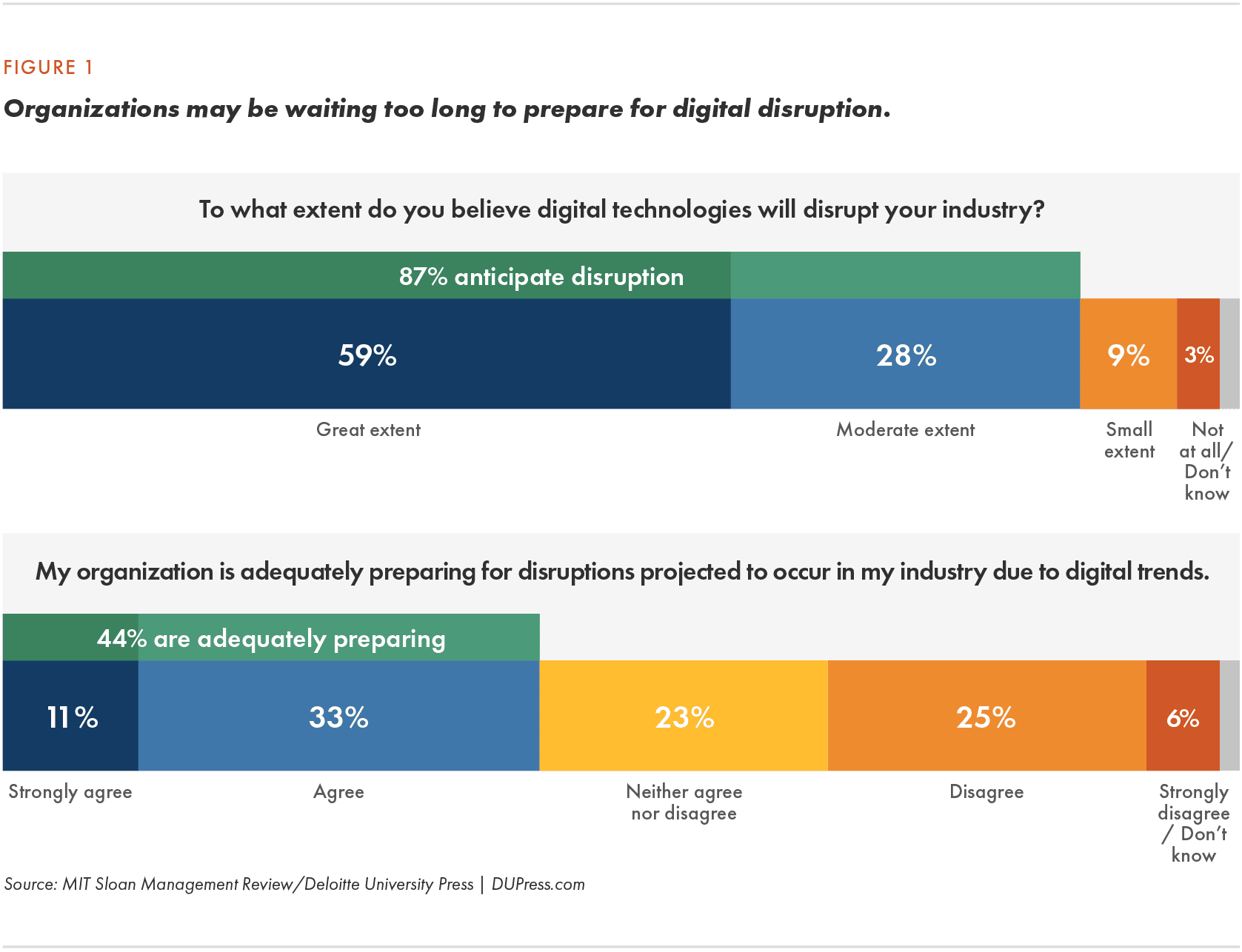
When we ask CEOs about their digital strategy, their first impulse is to direct us to their Chief Technology Officer or Chief Information Officer. While these roles are key stakeholders in delivering a digital strategy, they are not where critical decisions should be made.
There’s a fundamental difference between effectively leveraging technology and doing what it takes to achieve strategic growth and truly become a ‘digital’ organization. While technology is about tools and the platform and software and hardware that enable digital strategy, these alone do not make a digital strategy.
‘Being digital’ is about how to conduct business in today’s online, hyperconnected world – how to succeed and grow in a world of digital competitors.
Our marketplaces are filled with companies on both sides of the fence: those that understand and internalize what it means to be digital and those that still don’t get it. The gap between these two forms a chasm, which over time, becomes harder and harder to cross.
Successful digital organizations realize there really is no ‘digital’ strategy. It’s just strategy. It’s not a technology conversation, it’s a business one — and it’s a critical one to have, no matter your industry, your products and services, or your customer mix.
A 5-stage digital strategy framework
In this guide, we will walk you through a five-stage digital strategy framework, to put you on the right path to growth and value. This framework has been used with dozens of companies ranging from Fortune 500 to traditional long-standing manufacturing organizations. While each company has its own unique goals and challenges, the path to digital strategy involves common fundamentals.
And this framework must be explored before diving into practices such as technology planning, selecting technology tools, or even discussing digital product management strategies. All of these components will help you get there, but only once you understand your customers and how you fit in the – now digital – marketplace can you become a truly digital organization.
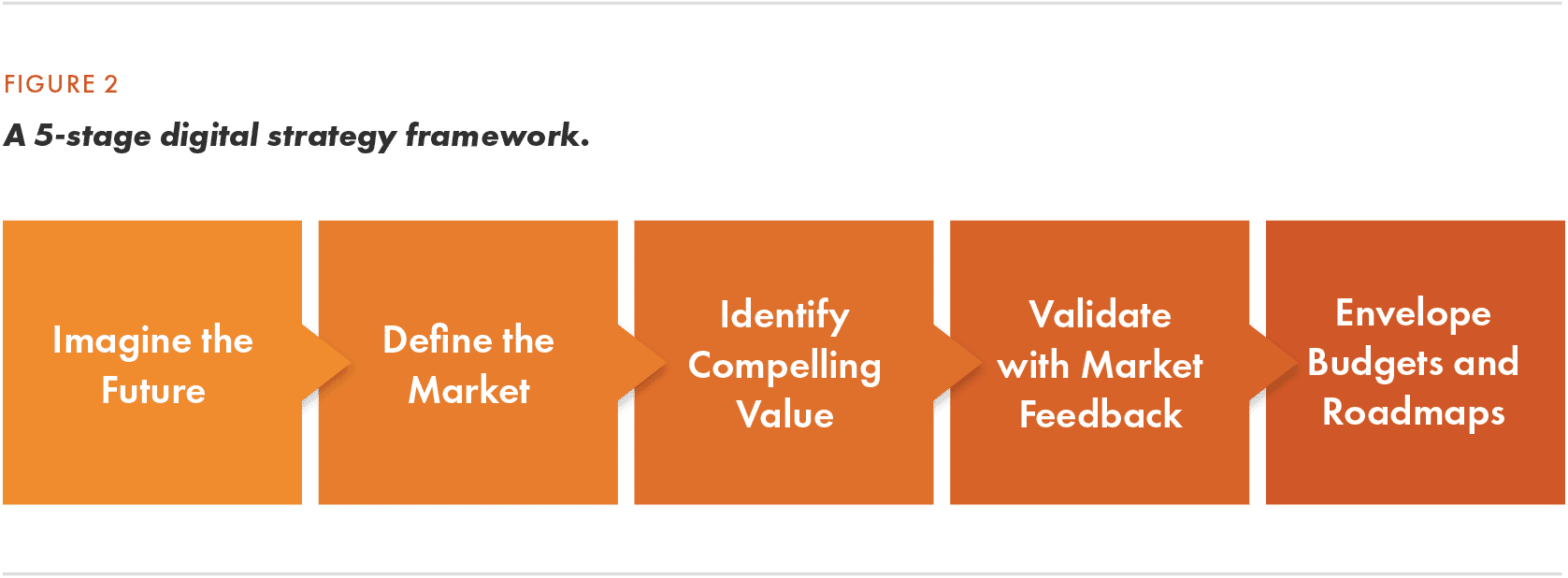
Part I: Imagine the future
Digital strategy is built on innovation, which starts by looking ahead and casting vision across the market landscape. There are a couple of ways to do this in your organization.
Start by asking 3 key questions:
- Where are my organization’s current and future opportunities?
- How is the market likely to shift over the next 5-10 years, and how can we best take advantage?
- What startups are out there eating our market share, and how can we use our legacy advantages to beat them at their own game?
Leaders also may consider writing a Back to the Future narrative with their team. This is a short document where you imagine yourself looking back from a time in the future – when your current projects are completed and you’ve achieved your goals. Reflect on where your team and your organization will be in terms of customer relationships, financials, competitive positioning, and more.
This exercise can bring clarity to your efforts and help leaders figure out their biggest strategic priorities.
The role of innovation and ambidexterity
To imagine the future, it’s essential that leaders foster organizational ambidexterity. This is a delicate balance between the present and future.
Without realizing, companies can often get stuck focusing exclusively on what’s required to survive – putting out fires and responding to crises in the moment. However, to thrive long-term, organizations and leaders must constantly be developing innovative new ideas, new products, and new ways to interact with customers.
Innovations can break down into three types:

Finding innovative ideas
To figure out the right innovations for your business, leaders should consider looking at innovations from different industries. Ideas gained outside your own market and industry can offer incredible value and, because they’re not a copycat of a competitor, often come across as much more fresh and new.
If you’re curious about how insights from other industries might drive innovation in your organization, check out these ideas regarding innovations in the hotel industry.
For example, think about how products can become services. Take the case of Amazon Web Services, which changed the computer server business from buying physical boxes to a service you could rent. This shift completely changed the industry and launched a revolution of products-turned-services in hundreds of spaces.
The future is not about you
The most important thing to remember when considering any innovation is to make sure your focus is squarely on the customer.
“Digital flops” can emerge when companies try to solve problems that don’t really exist. Or they’re innovating simply for the sake of innovation. As you imagine your ideal future, it’s critical to remember: it will only come to fruition if you keep the customer at the center.
Part 2: Define the market
Bringing your future state into reality starts by taking a comprehensive look at the market. Examine where your organization operates and where you fit among the other players. Be sure to move beyond mature market areas and account for emerging market players. This is imperative to understanding how to fend off challenges from digital upstarts.
Begin with a map
A market assessment should start with a mapping exercise that puts the customer at the center of the market ecosystem, and then identifies the businesses or organizations that enable, serve, or supply them.
This applies whether you’re selling products or providing services, in a for-profit or non-profit capacity. This market map must be completed before you can effectively evaluate your current market position or explore possible ways to expand it and unlock market opportunities.
Note: You may have more than one market map depending on how many markets you serve.

Revisit the value chain
Determining who you’re actually serving isn’t always easy. Leaders must understand the market not from their perspective, but from the customer’s viewpoint.
The people you intend to serve aren’t always the ones who are buying and using your offerings. Leaders need direct feedback from customers. In fact, this is a key responsibility of the CEO – to ensure your teams are gathering that feedback and not just relying on internal teams and their assumptions about the customer. As we often say at Mod Op Strategic Consulting, let nothing come between you and your customer.
Revisit the customer journey
Using the customer insights gained through this method allows you to build the range of personas that your organization serves, figuring out the customer segments and each of their specific needs. It’s critical to understand the 360-degree customer experience, and understand the customer journey from end to end.
To put this into action, leaders should consider a user-centered personas workshop.
Questions we recommend for executive teams to discuss:
- What are your personas’ biggest pain points?
- What do they use your product for?
- Why do they really hire your organization?
- What jobs are they trying to achieve?
Part 3: Identify compelling value
Once you understand your customers, it’s now time for a laser-focused approach to figure out the points of greatest value to them. This calls for primary market research.
Primary market research plays a significant role in helping discover:
- Credibility for big decisions
- Actionable insights for all aspects of product development
- The opportunity to discover unexpected surprises
- Valuable competitor intelligence
- Raw data for future research and investigation
Avoiding confirmation bias
Many organizations do not have the expertise in house to conduct thorough market research. Even if they do, they may be plagued by confirmation bias or the curse of knowledge. As a result, it may be a good idea to identify a third party company to help select the right research approach, whether that means phone interviews, focus groups, surveys, customer experience software platforms — or a combination of all of those tools.
Additionally, in our experience helping customers with market research, we’ve found that an unbiased third-party also eliminates the potential influence of “friendly customers” trying to please (or angry customers determined not to).
Differentiating user and customer needs
One important consideration when looking to find the most compelling value propositions your offerings provide is to separate “users” from “customers.” There is a lot to gain from looking at everyone who uses your products and services, absolutely — but it’s the people actually paying the bill, and making the purchasing decisions, whose needs ultimately matter most.
If users aren’t pulling the trigger and opening their checkbooks, you simply aren’t providing enough value and you must explore their “job to be done” more thoroughly.

This framework known “Jobs to be Done” is used widely in software and technology development, but is applicable to aligning products and services to the needs of your customers in all industries.
Emerging from insights by the late Clayton Christensen of Harvard Business School in a 2016 article in the Harvard Business Review, the JTBD framework poses the theory that customers “hire” products and services to do the jobs they need to get done, large and small. By understanding those jobs and designing your offerings to help your customers complete them successfully, you can find the way to add the most compelling value to their lives.
Once you do the research and see where the value is, you’re ready to move on to the next stage, and validate what you’ve heard by actually putting products in front of potential customers and seeing how they react.
Part 4: Validate with market feedback
This is one of the key points in the process where you have to understand that digital strategy isn’t really about digital tools and new technologies, but simply about the way you approach your business. Digital is not a strategy. Digital is a way of being.
Effective CEOs recognize that everything in business today is digital.
Building feedback loops
Leaders must create constant feedback loops to gather, interpret, and incorporate feedback from all directions. These feedback loops are then used to iterate and put ideas, prototypes, and new products and services in front of customers as quickly as possible.
This agile process allows organization to test hypotheses, better align products to customers’ needs, and mitigate the risk of product failure or lack of adoption.
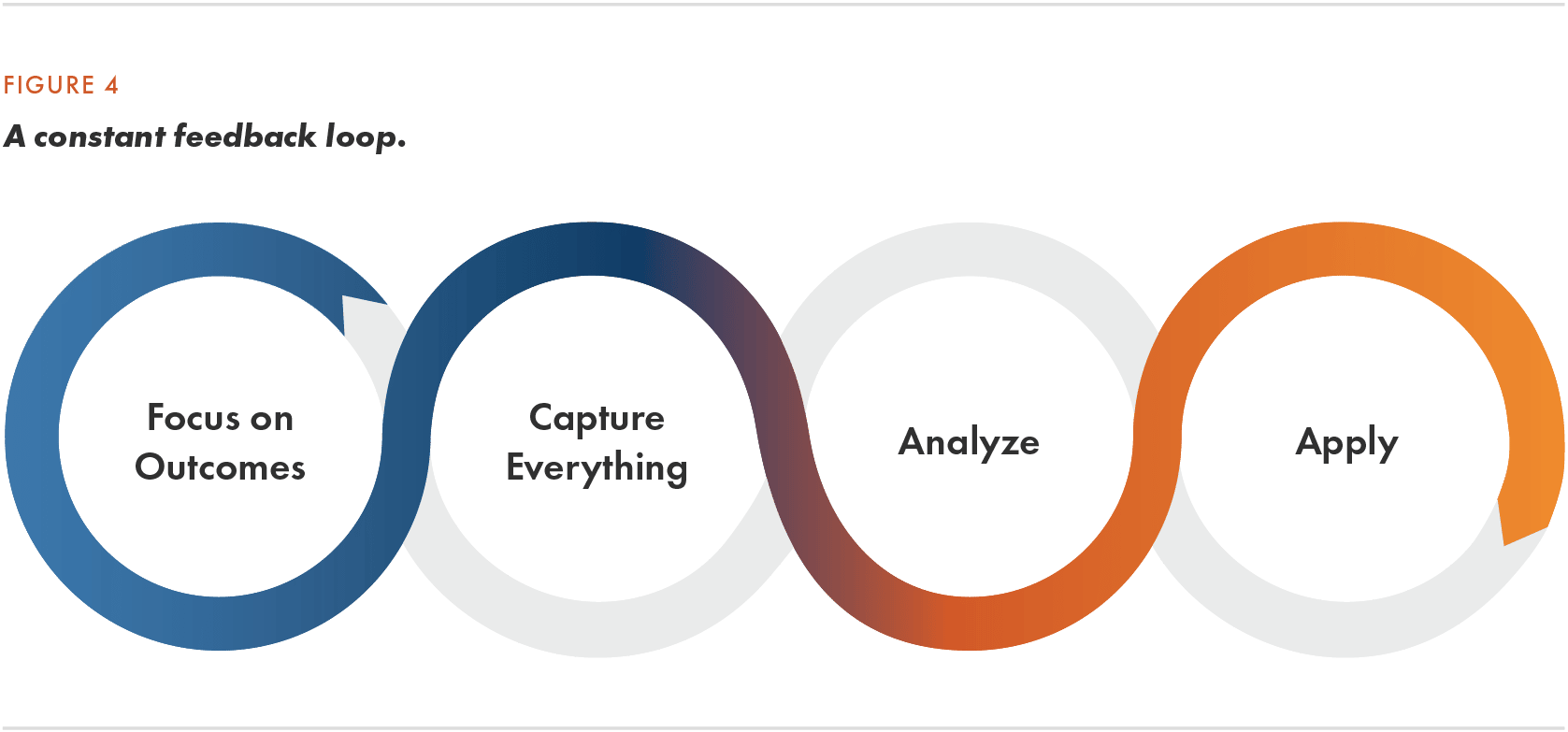
The reality is: You can never be too early to test the market. It’s also impossible to test it too often. In fact, in our experience our consultants would recommend that every company test the market far more often than they already do.
Building momentum, not perfection
It’s easy to get caught up in developing the perfect product, wanting it to be fully developed and ready to launch. However, you need to see what customers have to say at a far earlier stage in the process. It’s not a knock against your intuition to back up instincts with data. Use wireframes, descriptions, and diagrams – even before the product exists.
Ask specific questions such as:
- How important would a product like this be to a customer
- How useful would it be and to what teams?
- What do their budgets look like in the coming cycle?
Business case example: A financial services company was convinced they had a winning new product concept — until Mod Op Strategic Consulting consultants talked to 100 prospective customers about the idea. Their feedback led to a significant shift in focus, resulting in a product that was far more in line with market need than the original vision had been – and nearly tripled their revenue! That’s the magic of early testing.
It’s a red flag when organizations don’t want to invest in creating prototypes and conducting robust market testing.

Making iteration a habit
Agile development like this is how you accelerate product delivery and make sure you’re building the right products, to fill the white space in the market.
This is what being digital is all about: iterative processes to build feedback loops that start with insights and data from customers and products which feed into the core processes of a business and drive decision making.
It’s similar in some ways to the revolution that started with Henry Ford’s automobile assembly line. Ford completely changed how cars were made, just like the digital thinking here can completely change how you operate as an organization.
Part 5: Budgets and roadmaps
Finally, a digital-minded CEO needs to look at budgets and roadmaps. You can’t get to where you want to go quickly or effectively without a map. To achieve strategic growth through digital transformation, the map also helps lay out the steps along the way.
Budgets require maps
Roadmapping is critical at this stage. It informs how you should be allocating your budgets.
Too often, especially with mature organizations, upwards of 90 percent of the budget is focused on running and not growing. This locks funding up into the current structure, whether that’s existing infrastructure and products, or integrating previous efforts from over the past 40 years. Very little is allocated to forward-looking investment or innovation.
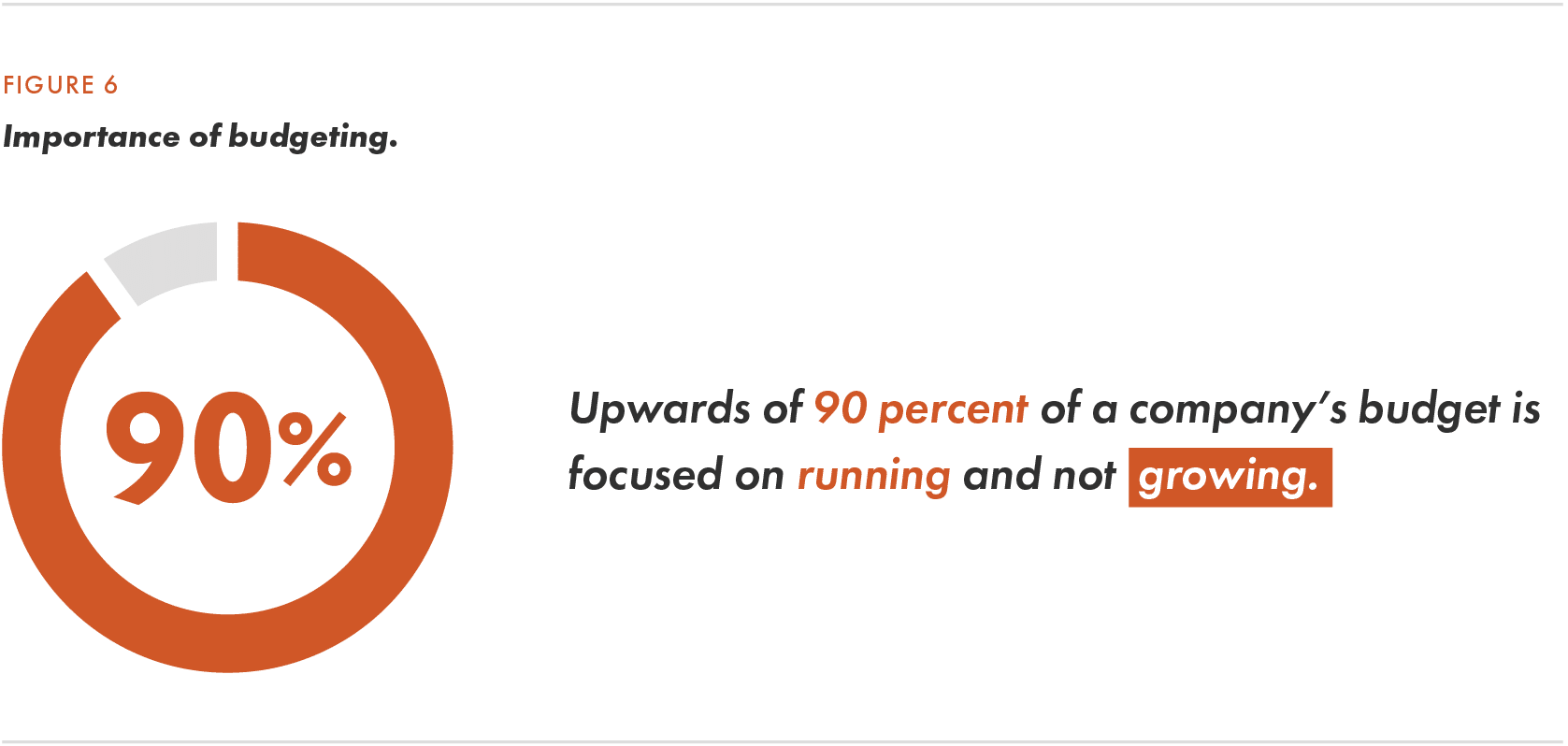
Budgeting for existing operations without adequately allocating dollars for future growth is one of the biggest mistakes an organization can make.
You need to spend capital to drive growth. Part of that spend will need to be focused on digital product management, to keep iterating, and not just rest on the merits of the products and services you already have. The other part of that spend will require new infrastructure, new technology, new people, and new processes that can propel you forward on your journey.
Budgeting ratios
The best way to allocate resources across budget functions is to ask whether that function is needed to “run” the business, “grow” the business or “transform” the enterprise. A commonly accepted target ratio for mature companies using the run-grow-transform model is 55/40/5.
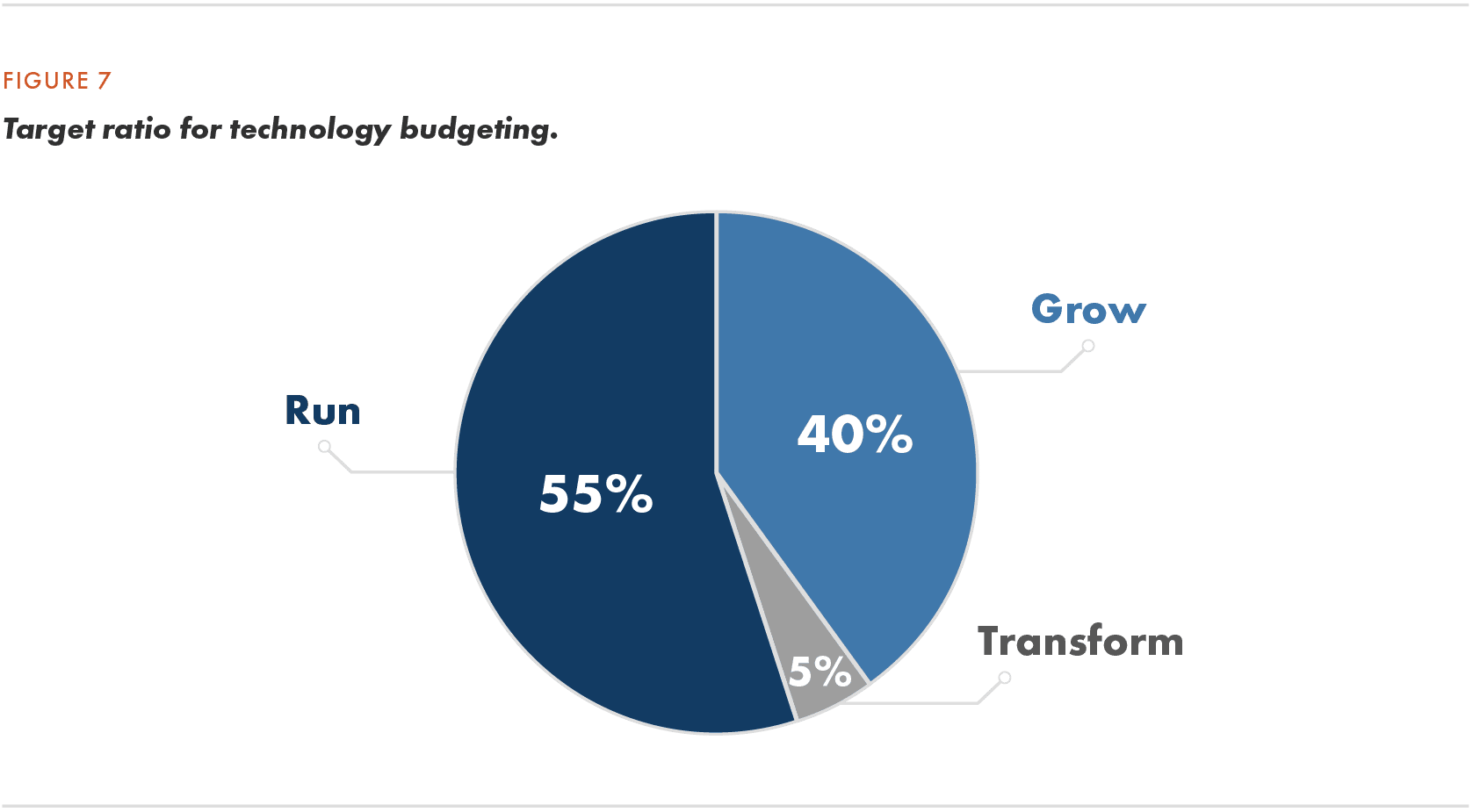
One benefit of this approach is that it ensures you will reserve at least a portion of your investment for experimentation with leading-edge capabilities such as cloud services, machine learning or robotic process automation. For a deeper look at technology planning and budgeting specifically, explore Mod Op Strategic Consulting’s Definitive guide to strategic technology planning for CEOs.
Conclusion and next steps
As a final reminder, it is imperative that the investment and commitment to digital strategy start at the top – and that’s with you, the CEO, and the other leaders in the C-suite.
We hope you’ve found this guide helpful in thinking about how to modernize your organization’s business processes so you can help make the digital leap.








